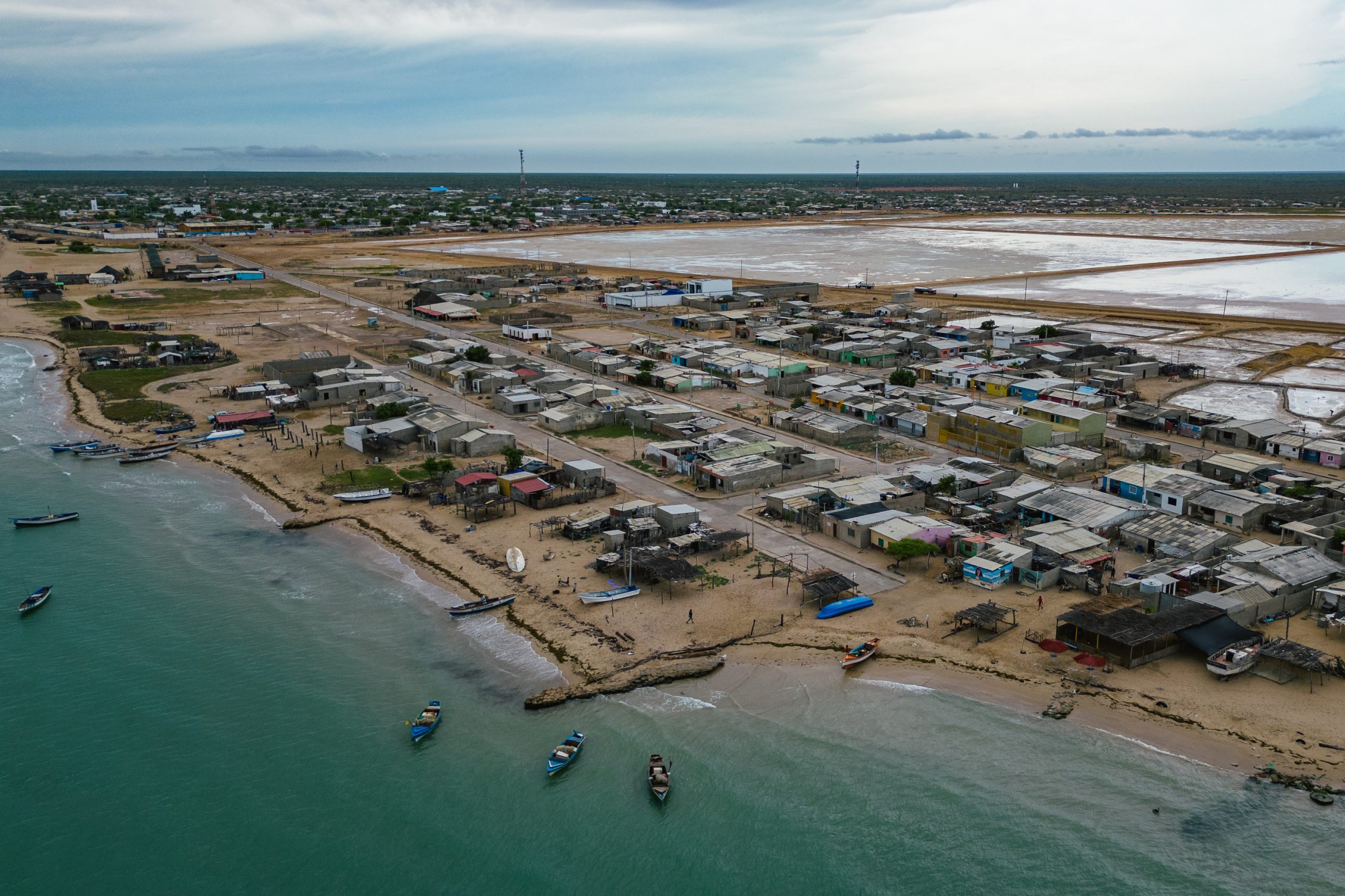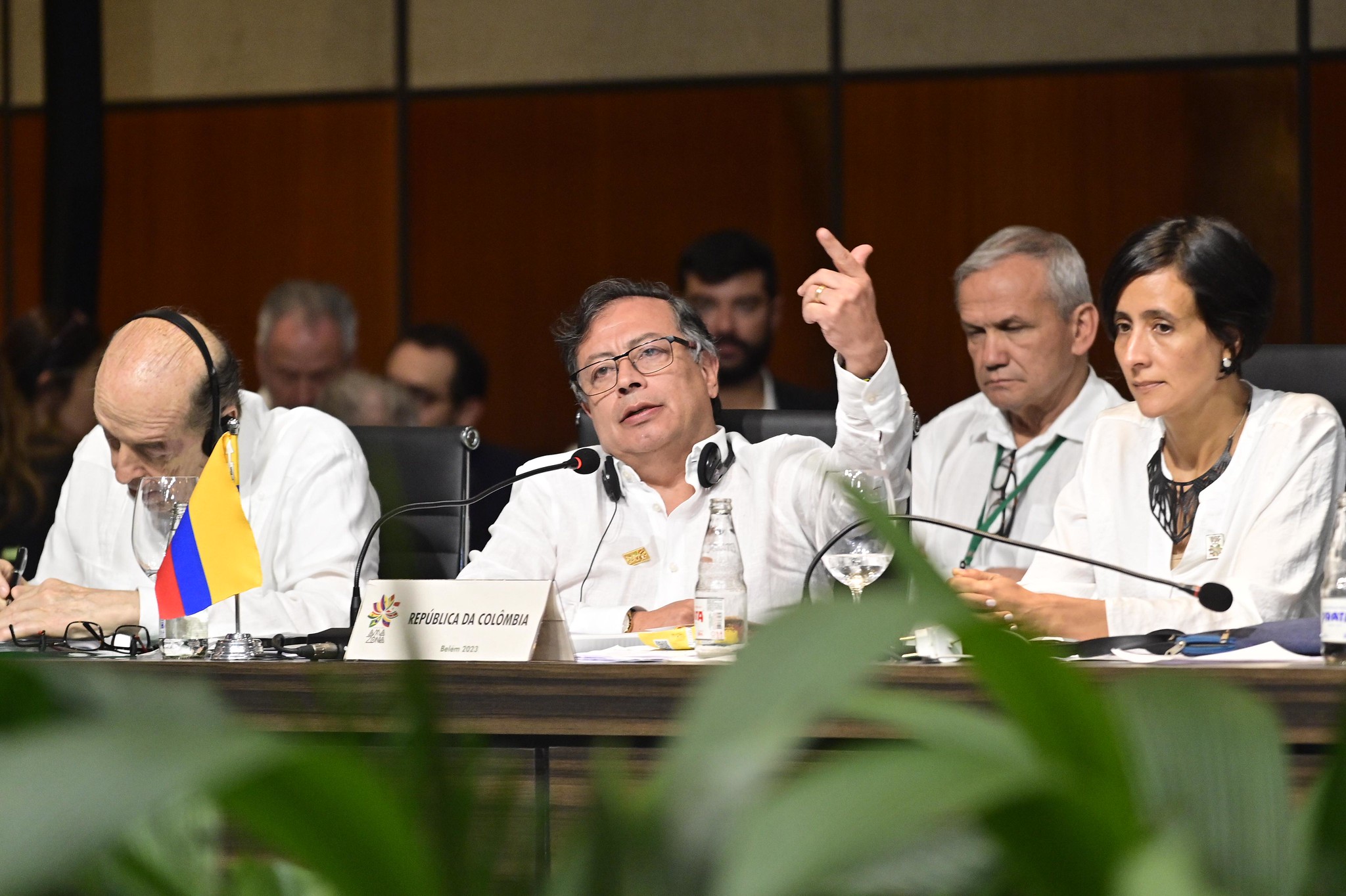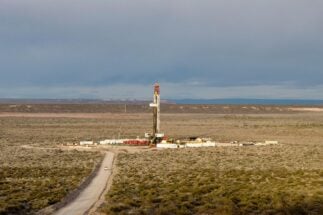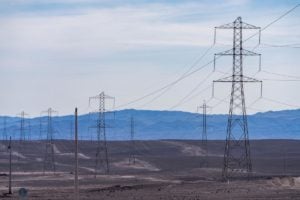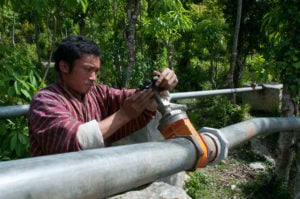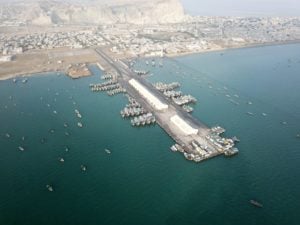When he took office in 2022, Colombian president Gustavo Petro promised to turn his country into a “world power of life”, making decarbonisation and environmental protection a central mission of his government.
He has also attracted global attention for his passionate speeches on environmental justice and the energy transition, heard at the United Nations’ General Assembly, the World Economic Forum in Davos, and climate COPs in Egypt and the United Arab Emirates.
However, now over a year and a half into his term, experts and data agree on one thing: most of Petro’s proposals for a greener Colombia are plausible – and necessary for one of the most biodiverse countries on the planet – but he has so far fallen short in practice.
More than 20 promises on energy and environment were identified in the president’s 2022 government plan, though concrete progress has only been made on eight of them, our analysis found. Making good on most of these pledges before August 2026, when his term ends, is also likely to be complicated.
Petro’s energy promises
 No progress
No progress1 – Strengthen research, science and technology, promote the development of technical, technological, professional and postgraduate training programmes oriented towards the energy transition, building skills to take on the job opportunities that the transition will provide.
2 – Create a fund for the energy transition with resources from taxes and those coming from the elimination of some tax benefits for the hydrocarbon, coal mining and hydroelectric sectors.
3 – Create the National Clean Energy Institute.
4 – Stimulate the implementation of small, medium and large-scale hydrogen projects and their respective transport and distribution systems.
5 – Promote biogas generation associated with agricultural and livestock projects and the use of solid waste.
6 – Promote a reform of the current mining code and an institutional adjustment based on the energy transition and the new mining-energy public policy, with an environmental and social perspective.
 Slow progress
Slow progress1 – Promote technologies that enable the potential of wind and solar energy to be developed. Prioritise solar energy production in La Guajira department, in mixed ownership with 17 Wayúu communities, coal mining workers and producing municipalities. To achieve this, an ambitious plan for solar roofs and solar farms will be promoted in the areas with the greatest solar exposure in the country.
2 – Gradually reduce the model based around extractive industries, in order to avoid economic dependence on oil and coal.
 Promises kept
Promises kept1 – Strengthen the public vehicle fleet and encourage the use of electric vehicles and recharging stations.
2 – The exploration and exploitation of unconventional oil fields will be banned, and fracking pilot projects as well as the development of offshore fields will be stopped.
3 – No new licences will be granted for hydrocarbon exploration and large-scale open-pit mining will not be allowed.
4 – No more hydroelectric dams will be built.
Petro’s environmental promises
 No progress
No progress1 – Recognise animals as sentient beings, therefore, their dignified treatment will be promoted, and wildlife trafficking will be tackled.
2 – Advance in the closure of open-air waste facilities throughout the country.
3 – Promote technological parks for the reuse of waste through alliances with communities.
 Slow progress
Slow progress1 – Strengthen research in environmental sciences by promoting creative and collaborative work between communities, higher education institutions, research institutes and intercultural recognition of traditional and ancestral knowledge to foster a new relationship between society and nature in the face of the global environmental crisis.
2 – Guarantee universal and free access to environmental, risk and climate change information so that citizens can exercise their constitutional right to participation.
3 – Provide guarantees for environmental defenders and leaders. In addition to protecting individuals, the causes and perpetrators of the environmental conflicts that motivate their struggles will be investigated and expedited mechanisms for their resolution will be put in place.
4 – Build a great national pact of regional and global significance for the environmental defence of the Amazon, Orinoco and Pacific regions.
5- Promote the prohibition of all types of events that involve animal abuse, including bullfights. The use of public venues and resources for these purposes will not be allowed.
6 – Promote the development and systematic use of biodegradable materials that allow the elimination of plastics in packaging, packing and storage.
7 – Guarantee the constitutional protection of the waste picker population through affirmative actions, the official recognition of their status as workers, the strengthening of the popular economy, and their role as protagonists in the fight against climate change.
8 – The National Science, Technology and Innovation System (SNCTI) will be the instrument to achieve the articulation, at local and regional levels, between universities, entrepreneurs, communities and public entities, in order to stimulate the improvement of productivity, based on the recognition of territorial context and potential. As the head of the system, the Ministry of Science, Technology and Innovation will guide policy and ensure its robust financing. Regional Innovation Systems will be strengthened and consolidated.
 Promises kept
Promises kept1 – Ban single-use plastics. (The law banning certain single-use plastics was passed by congress on 1 June 2022 and will come into force in 2025.)
Despite winning praise from environmentalists on the international stage, Gustavo Petro has faced less favourable political winds domestically: public approval of his administration has fallen from 56% when he came to power in August 2022 to 26% by December 2023.
Many of his government’s flagship policy goals – his pursuit of “Total Peace” in Colombia, plus health, pension and labour reforms – have yet to achieve clear results, or have been shipwrecked in a sea of stumbling blocks in congress. In just a year and a half Petro has faced two ministerial crises, and a third is looming as debates around his reforms continue.
Diálogo Chino consulted experts in the energy and environment fields, as well as official data and other analyses, to assess the progress of Gustavo Petro’s government on 24 environmental pledges, as identified by local science and tech publication Pesquisa Javeriana.
Clean energy
Twelve of the Petro administration’s 24 environmental proposals related to the transition to clean energy – a priority for the president, in a country that depends heavily on fossil fuels for its energy needs, and whose sizable hydropower sector faces long-term questions.
Among these pledges were the creation of a National Clean Energy Institute to coordinate strategy in this area, and an energy transition fund, though no firm details have yet emerged over these plans. However, Colombia has still attracted international finance to support clean energy projects during the Petro administration, including from the World Bank, the German government, and the multilateral Climate Investment Fund.
The pledged expansion of renewable energy under the Petro government has been slowed by regulatory obstacles and social conflicts. Mining and energy planning body UPME had laid out plans for 11.4 GW of solar and wind power to be added between 2023 to 2027, but almost half of all projects are said to be running behind schedule.
One of the most significant developments has been the government’s agreement with Indigenous groups to improve consultations over projects and allow them to partner with companies in wind and solar initiatives. This could be particularly important for the Wayúu people of La Guajira, a region at the northern tip of Colombia that has been targeted as the “epicentre” of the country’s energy transition, but where conflicts have emerged between communities and companies over renewables projects.
The Petro administration has also sought to reform Colombia’s mining code, to bring it “in line with the energy transition and with an environmental and social perspective”. Only one bill has so far been proposed in this regard, but it was shelved in mid-2023.
One advance has been seen on electromobility. At the end of 2023, the Ministry of Mines and Energy issued a resolution that aims for all petrol stations to have charging points for electric and hybrid vehicles by 2026.
The president has also halted the signing of new coal, oil and gas exploration contracts, as well as fracking projects, open-pit mining licences and the construction of hydroelectric dams.
However, these decisions have been criticised by some experts, including government allies, who claim that they have been taken in an improvised manner and could lead to Colombia losing its energy sovereignty and self-sufficiency in oil and gas in the medium term.
What would it mean for Colombia to continue exploring for oil that perhaps no one will want to buy in 2035?Manuel Guzmán Hennessey, director of the Klimaforum Latinoamérica Network
Manuel Rodríguez Becerra, who served as Colombia’s first environment minister in the 1990s, told Diálogo Chino that he believes suspending oil and gas exploration is “a big mistake”. The country, he said, “depends heavily on these exports and economically it would be a huge blow to have to import these hydrocarbons.”
According to the Colombian Oil and Gas Association, the sector accounts for 40% of the country’s total exports. The Colombian Bank of the Republic, meanwhile, reports that 72% of foreign direct investment in 2022 came from the mining and oil sector.
“Colombia must fulfil its commitment to reduce its greenhouse gas emissions by 51% by 2030, but 59% of its emissions currently correspond to deforestation, land use and livestock, so the priority must be elsewhere,” says the former minister; the figure also includes all agriculture emissions, beyond just livestock farming. Rodríguez Becerra says he agrees with replacing fossil fuels with renewable energy and diversifying the economy, “but without sacrificing economic growth”.
Manuel Guzmán Hennessey, a climate change professor and director of the Klimaforum Latinoamérica Network, believes the announcement that there will be no new exploration contracts must also be read in the international context.
“What would it mean for Colombia to continue exploring for oil that perhaps no one will want to buy in 2035?” he asks. “The government’s strategy for decarbonising the economy is not focused exclusively on the abandonment of fossil fuels, but on reindustrialisation and integration with new local economies, and that path is just being designed by the Ministry of Commerce, Industry and Tourism.”
On the other hand, Petro has boasted before international audiences, at both COP27 and COP28, that 70% of the electricity generated in Colombia comes from clean sources. In 2023, hydropower accounted for 66.8% of installed capacity, while thermal energy made up 30.5%; wind and solar collectively represented 1.6% of capacity. In 2022, a year characterised by heavy rains and raised water levels, electricity generation from hydropower reached 83%.
As the fact-checking media Colombia Check pointed out, however, Petro has not acknowledged in his speeches that this is a long-standing success for the country’s electricity sector, and an achievement that predates his government.
Amazon, deforestation and foreign debt
Colombia’s president also arrived with promises of increasing the protection and conservation of nature, and its defenders.
Petro’s government programme pledged to “build a great national pact of regional and global significance for the environmental defence of the Amazon, the Orinoquía and the Pacific”; he repeatedly committed to ratifying the Escazú Agreement, the landmark regional treaty seeking to promote justice and public participation in environmental matters in Latin America and the Caribbean; and he sought to “offer guarantees for environmental defenders”, in what remains the deadliest country in the world for such actors, according to rights NGO Global Witness.
On the first promise, a start has been made: the summit of Amazon leaders held in the Brazilian city of Belém in August 2023 saw some steps forward in regional cooperation, including on the policing of environmental crimes, but was seen by some observers as underwhelming.
On Escazú, Petro has made good on his pledge: Colombia’s congress finally approved the law that ratified the treaty in November 2022. An environment ministry source told Diálogo Chino that its implementation has already begun with the “development of citizen participation strategies that facilitate timely and effective access to public information to empower leaders and communities in the environmental defence of their territories”, among other actions. However, some experts have said that the plans for implementation must be more ambitious and profound, and better link different actors and sectors.
Given the complexity of drivers and issues behind the threats environmental defenders face, confronting this pledge is much more complex for the government. Acknowledging that it is not a purely environmental issue, the environment ministry affirmed that “a route of intersectoral articulation has been established”, and that a “protocol has been created to react to situations of risk or aggression of defenders of the land and the environment.” However, the threats and murders continue, and impunity in judicial investigations for these cases appears not to be the exception but the rule.
In addition to the promises laid out in his government programme, Petro has used international appearances to announce that Colombia will spend US$200 million annually for the next two decades to “save the Amazon”. His government has also pledged to restore more than 750,000 hectares of land during its four-year term.
On the Amazon, it should be noted that a significant portion of the resources for the biome’s protection come from the international community, and there are still no records that prove that the $200 million domestic investment was made in the first year of government. However, there has been cause for celebration, after official statistics showed that deforestation in the country decreased by 29.1% in 2022, compared to 2021; in the Amazon it was reduced by 36.4%. There are signs that 2023 was even more impressive, with the environment ministry estimating that deforestation was down 70% in the first nine months of last year; official data on the entire year is expected to be ready in the coming weeks.
As for the restoration target, this has been described as very ambitious, but has been met with some scepticism. For Rodríguez Becerra, simply fulfilling this promise would see Petro leave “a great legacy to Colombia”, but question marks remains on the capacity to implement a plan that not only depends on the national government, but also on local governments, the regional environmental authorities and the communities themselves.
“In addition, since it is not traditional reforestation but rather comprehensive restoration, the project is quite complex because it also involves the intervention of scientific entities and having the necessary plant material. There are doubts that the country currently has enough nurseries to provide that material, which can be very different depending on the ecosystem it reaches,” says the former minister.
According to the figures provided by the environment ministry, there are currently concrete restoration plans for almost 45,000 hectares. At that rate, considering that the annual goal set by the government itself is 187,500 hectares per year, the prospect of meeting this target seems distant.
Another target of the Petro government is to secure debt relief from external lenders, in exchange for investment in adaptation and mitigation to climate change, including initiatives know as debt-for-climate or debt-for-nature swaps. Such swaps are not entirely new, with several initiatives carried out in Colombia in the 1990s involving the United States and Canada. Debt-swaps as a concept have received a mix of praise and criticism from environmentalists and financial analysts.
The question, however, remains the same. Hernando Zuleta, an economics professor at the University of the Andes, told local media that Petro has been consistent in his calls for debt relief, and for Latin American countries to gather around this cause. “But it remains to be seen how he goes from speeches to actually turning it into a regional position that countries can share, which can help defend Brazil or Argentina,” he added.
Guzmán Hennessey, for his part, does not believe such debt relief will be easy to bring about, “because it depends on international actors and because the president has not yet been able to realise his dream of Latin American leadership.” He says Petro was a “solitary voice” at COP28, with regional leaders not coming together as a bloc. “To put forward a proposal [on debt and conservation] of this magnitude, it is necessary to mobilise the will of its neighbours, at least those of the Amazon forest.”
For now, one of the only concrete measures to emerge on the external debt issue is an announcement made at COP28, that the governments of Colombia, Kenya, France and Ghana will lead a review by international and independent experts into the impact of debt on the ability of developing countries to conserve nature, adapt to climate change and decarbonise their economies.
The year ahead could be a significant one for international efforts to protect nature, and for Colombia’s role in them, as the country prepares to host the UN biodiversity COP16 in the city of Cali from 21 October to 1 November. With the eyes of the world focused more closely than ever on the environmental ambitions central to Gustavo Petro’s platform, it will perhaps be more necessary than ever for the president to close the gap between his grand speeches and concrete achievements.
This article was produced in partnership with Vorágine, a Colombian investigative journalism platform.

